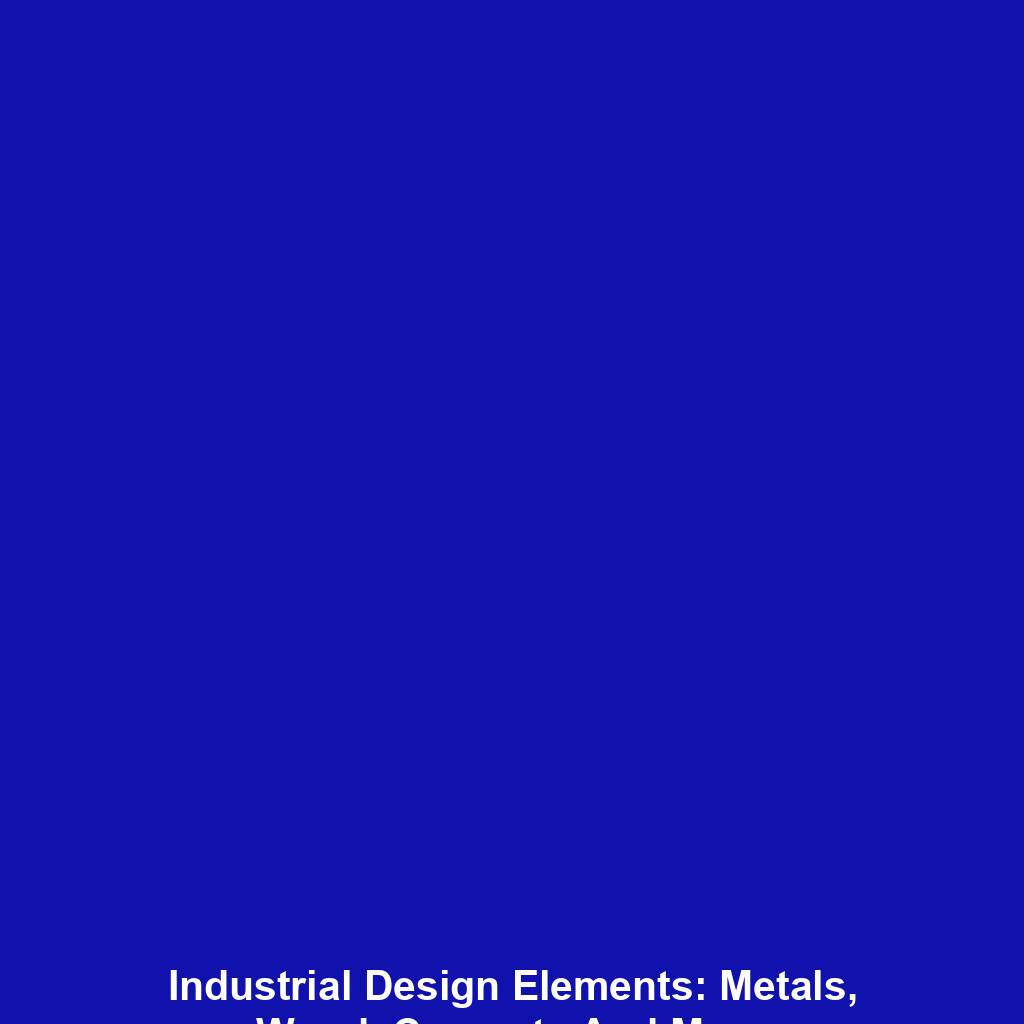In the world of industrial design, a harmonious combination of materials is crucial to achieving a visually appealing and functional result. Metals, wood, and concrete, along with various other elements, play a pivotal role in creating designs that are not only aesthetically pleasing but also durable and practical. These materials offer unique qualities and characteristics that bring about a sense of sophistication and ruggedness to any space, making them essential components in industrial design. Throughout this article, we will explore the versatility and significance of these design elements, uncovering the ways in which they can be utilized to create captivating environments.
Metals
Types of Metals
In industrial design, metals are widely used for their strength, durability, and versatility. There are various types of metals commonly utilized in industrial design, including steel, aluminum, copper, brass, and titanium. Each type of metal has its own unique properties and characteristics, making it suitable for different applications in industrial design.
Steel, for example, is known for its exceptional strength and corrosion resistance. It is commonly used in the construction of buildings, bridges, and machinery due to its ability to withstand heavy loads and harsh environmental conditions. Aluminum, on the other hand, is lightweight yet strong, making it a popular choice for aerospace applications, automotive parts, and consumer electronics.
Copper and brass are valued for their excellent conductivity and aesthetic appeal. These metals are often used in electrical wiring, plumbing systems, and decorative elements in industrial design. Titanium, with its high strength-to-weight ratio, is frequently utilized in the aerospace industry, medical devices, and high-end sports equipment.
Characteristics of Metals in Industrial Design
Metals possess several key characteristics that make them ideal for industrial design applications. Firstly, metals are known for their strength and durability, allowing them to withstand heavy loads and resist deformation. This makes them suitable for creating structural components and machinery that need to endure challenging conditions.
Secondly, metals have excellent thermal properties, allowing them to efficiently conduct heat and cold. This feature is particularly valuable in applications such as heat sinks, cookware, and automotive parts that require effective thermal management.
Additionally, metals can be easily fabricated and formed into various shapes and sizes using techniques such as casting, forging, and machining. This versatility enables designers to create intricate and complex industrial design elements with precision.
Lastly, metals are highly corrosion-resistant, especially when properly treated with protective coatings or finishes. This characteristic ensures that metal elements can withstand exposure to moisture, chemicals, and other environmental factors, thus prolonging their lifespan.
Benefits of Using Metals in Industrial Design
The use of metals in industrial design offers several significant benefits. Firstly, metals provide exceptional strength and durability, making them a reliable choice for structures and machinery that need to withstand heavy usage or extreme conditions. This longevity also contributes to reducing maintenance and replacement costs in the long run.
Secondly, metals offer excellent aesthetic appeal, particularly when combined with other materials or finishes. The inherent shine and luster of metals can add a touch of elegance and sophistication to industrial design elements, making them visually appealing and enhancing the overall aesthetic value of a product or space.
Another advantage of using metals is their excellent conductivity, whether it be electrical, thermal, or even acoustic. This feature enables metals to be utilized in a wide range of applications, including electrical wiring, heat dissipation, and sound insulation.
Furthermore, metals are highly recyclable, making them a sustainable choice for industrial design. The ability to recycle metals helps reduce the demand for virgin materials and minimizes the environmental impact of the manufacturing process.
Popular Metal Finishes in Industrial Design
To enhance the appearance and functionality of metal elements in industrial design, various finishes and treatments can be applied. Some popular metal finishes include:
-
Polished Finish: This finish involves smoothing the metal surface to a high shine, emphasizing its natural luster and reflective properties. Polished finishes are commonly used in decorative metal elements and architectural applications to create a sleek and sophisticated look.
-
Brushed Finish: Brushing the metal surface creates a series of fine parallel lines, giving it a distinctive textured appearance. This finish is often used in furniture, appliances, and automotive components to add a modern and industrial touch.
-
Satin Finish: A satin finish is achieved by sanding the metal surface to create a smooth, matte appearance with a subtle sheen. This finish is frequently employed in interior design and consumer products to create a luxurious and refined aesthetic.
-
Powder Coating: Powder coating involves applying a dry powder to the metal surface, which is then cured under heat to create a durable and attractive finish. This method offers a wide range of colors and textures, providing designers with versatile options for customization.
Examples of Industrial Design with Metal Elements
Metal elements can be found in various industrial design applications, demonstrating their versatility and importance. For instance, in architecture and interior design, metals are commonly used for structural elements such as beams and columns, as well as decorative features including railings, fixtures, and furniture.
In product design, metals are utilized in a wide range of consumer goods, such as appliances, electronics, and kitchenware. The sleek and modern appearance of metals adds a touch of sophistication, while their strength and durability ensure the longevity of these products.
Additionally, the automotive industry heavily relies on metals for the manufacturing of vehicles. From the chassis and body panels to engine components, metals provide the necessary strength and safety features required for automotive design.
Overall, metals play a crucial role in industrial design, offering a combination of strength, versatility, and aesthetic appeal. Whether it is in architecture, product design, or automotive applications, metals continue to shape and enhance the world of industrial design.
